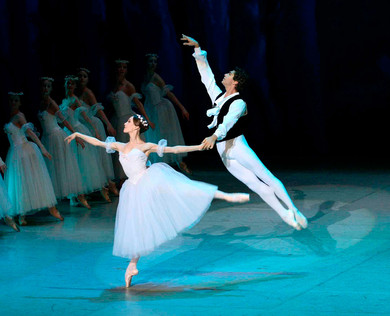Chopiniana
| Credits |
|
Choreography by Mikhail Fokin (revisions) Yuri Fayer, Musical Director
|
Premiere of this production: 21 May 2010 Running time: 35 minutes
From the History of the Ballet
Chopiniana is the first of Mikhail Fokine`s masterpieces. The twenty-six-year old choreographer composed it for one of the usual charity performances, which were organized in Petersburg in their hundreds, in order to add novelty to a classical repertoire that set the teeth on edge. But if today we were to see the Chopiniana that was presented on February 10, 1907, we would not recognize it: it consisted of four little genre scenes to the music of a polonaise, nocturne, mazurka and tarantella, orchestrated by Alexander Glazunov.
In the Polonaise, Poles danced with great verve in a ballroom. In the Nocturne, Chopin himself wrestled with his nightmares and met his muse amidst the ruins of a monastery. In the Mazurka, a girl, who was being forced to marry an old man, eloped with her sweetheart. The Tarantella was danced in Italian costume against the background of Vesuvius. At Fokine`s request, Glazunov orchestrated, specially for the occasion, one more piano piece by Chopin, the 7th Waltz.
Anna Pavlova, whose exquisite appearance brought to mind the age of romantic ballet, danced in this waltz the role of the Sylphide, a sublime dream, eluding The Youth`s grasp. The choreographer-revolutionary who had spent his entire life fighting against absurdity in ballet, found in the romantic age a model of spirituality and poetry. Inspired by the images of the great romantic ballerinas of the XIX century and by Anna Pavlova`s dancing, a year later he created a new version of Chopiniana.
The premiиre took place at the Mariinsky Theatre on March 8, 1908. In it the brilliant Polonaise served but as an overture, forming a counterpoint to the elegiac mood of the overall ballet which consisted of: the Nocturne, 11th Waltz, a Prelude, two Mazurkas, 7th Waltz and 1st Waltz, forming the coda. The work had no plot. It just conveyed the mood of reverie and light melancholy, condition, veering between dream and reality, of The Youth-poet, who had found himself in the world of the Sylphides. The choreographer found an ideal cast for the premiиre: the main roles were danced by Anna Pavlova, Tamara Karsavina, Vaslav Nijinsky. And in 1909 they conquered Paris in this ballet during the first of Diaghilev`s Russian Seasons.
Chopiniana at the Bolshoi Theatre
In the hundred years of its existence, only very rarely Chopiniana has been performed by dancers with enough sensitivity to convey its stylistic nuances. The ballet occupied a very special place in Galina Ulanova`s career: she chose Chopiniana for her examination performance at the Leningrad ballet school, an occasion which introduced a unique lyrical dancer to the world of ballet, and it was in this same work that she gave her farewell performance at the Bolshoi Theatre.
Chopiniana had its Bolshoi Theatre debut in 1932, but soon after this it was dropped from the repertoire and it was not until 1958, thanks to the Leningrad choreographer, Yekaterina Heidenreikh, that it was returned to the Theatre on a more or less permanent basis. Since then not one outstanding Moscow ballerina or lead male dancer has passed the work by.
A real sensation was the 1961 debut in the ballet of Natalia Bessmertnova who, several years later, was to acquire an ideal partner in Alexander Bogatyrev. The following are among the dancers who have given acclaimed performances in Chopiana: Raisa Struchkova, Marina Kondratieva, Yekaterina Maximova, Lyudmila Semenyaka, Nikolai Fadeyechev, Maris Liepa, Boris Khokhlov, Alexander Godunov, Nina Ananiashvili, Alexei Fadeyechev. And today too Chopiniana remains a much desired work with the new generation of Bolshoi Theatre soloists.
Anna Galayda (text from the handbook, abridged)
|
|
Main Stage
1 Teatralnaya ploschad (1 Theatre Square), Moscow, Russia
New Stage
Bol'shaya Dmitrovka Street, 4/2, Moscow, Russia
|


